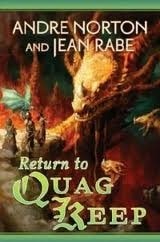Return To Quag Keep by Andre Norton and Jean Rabe (book review).
The 2006 novel ‘Return To Quag Keep’ by Andre Norton and Jean Rabe is a sequel to Andre Norton’s novel, ‘Quag Keep’. In 1976, Gary Gygax, one of the co-creators of ‘Dungeons & Dragons’, invited noted fantasy author Andre Norton to play his new game. In 1978, Norton published ‘Quag Keep’, inspired by that experience:
http://sfcrowsnest.org.uk/quag-keep-by-andre-nortonbook-review/
This reviewer understands that ‘Return To Quag Keep’ was collaboration between the authors and was one of the last books Norton contributed to. The original novel was interesting in that it presented the idea that the main characters are all being played in a game by individuals from another world, thereby novelising the idea of a role-playing game literally. At the end of ‘Quag Keep’, the exposition was kept deliberately obscure and so the reader had to supply their own understanding.
The sequel begins by showing us that the heroes of the first book, Milo Jagon the swordsman, Naile Fangtooth the beserker, Wymarc the bard, Ingrge the elf, Deav Dyne the cleric, Yevele the battlemaid and Gulth the Lizardman, have not found their way back to the `real’ world, but now have a clear memory of their former lives, despite remaining in the fantasy setting of Greyhawk. This new clarity is the first step the sequel takes towards explaining the vague nature of the first novel.
The actual story in the sequel is far less elegant than in the first volume. While the original had a fairly classic quest structure, this story immediately flings the heroes off in different directions and starts to tell several separate stories. While this might seem more sophisticated than the first novel, it also loses a lot in coherency. Furthermore, as if this web of different stories seemed too difficult to keep track of while writing, the authors proceed to completely ignore the story of some of the characters, while suddenly killing off one of the original heroes in a way that felt very jarring. This seems something of a pity, given I was just really starting to like that character.
The multiple threads of the story do allow the book to visit a wider diversity of locations and situations within this setting. The stories are written competently and this reviewer enjoyed seeing how the characters handled brushes with the law, caravan guard duty, fighting undead skeletons, evil magic and dealing with family-focused dragons in the desert. Overall, it weaves a more varied tale than the first novel and this lends it a greater feeling of depth.
After the various disparate quests, a resolution of sorts is found. However, due to the dispersed nature of our heroes, that resolution is not the same for all of them. Given the close-binding fellowship of the characters in the first novel, this feel somewhat unfair on some of them.
It must be observed that the actual writing shows little of the flair and character so obviously expressed by Norton in ‘Quag Keep’. Although competent, the prose here seems rather bland and characterless. It is easy to assume that Norton, obviously nearing the end of her life, might have contributed ideas and direction while Rabe did most of the actual writing. This might even account for the gain in clarity. Maybe Norton knew what she was doing with her obscurity, which certainly lent the former book a more mystical feeling.
Another technical note is that this book, while set in the same fantasy world as the first, never mentions any Greyhawk specific geography or place names (beyond the actual title itself). In 1976, the nature of D&D trademarks and copyright was somewhat more fluid, so perhaps it is understandable that specific references could not be made in 2006. However, this robs the book of much colour and is especially disappointing for the role-playing fan looking for more references to the early Greyhawk.
‘Return To Quag Keep’ seems to exist to finish off all the loose ends from the first book. Anything left obscure in ‘Quag Keep’ is here rendered clear. Anyone felt left in the dark at the end of the first novel could be well served to read this book for the exposition alone.
The level of the writing and themes portrayed are quite appropriate for a young adult audience, but without the specific Greyhawk references and lacking any real purpose other than as a sequel, I am not that anyone should ever pick this up without reading ‘Quag Keep’ first. I can see that there might be some value in answering the loose ends of the first novel and in this I enjoyed it.
Dave Corby
November 2013
(pub: TOR/Forge. 304 page hardback. Price: $24.95 (US), $33.95 (CAN). ISBN: 0-765-31298-0)
check out website: www.tor-forge.com





